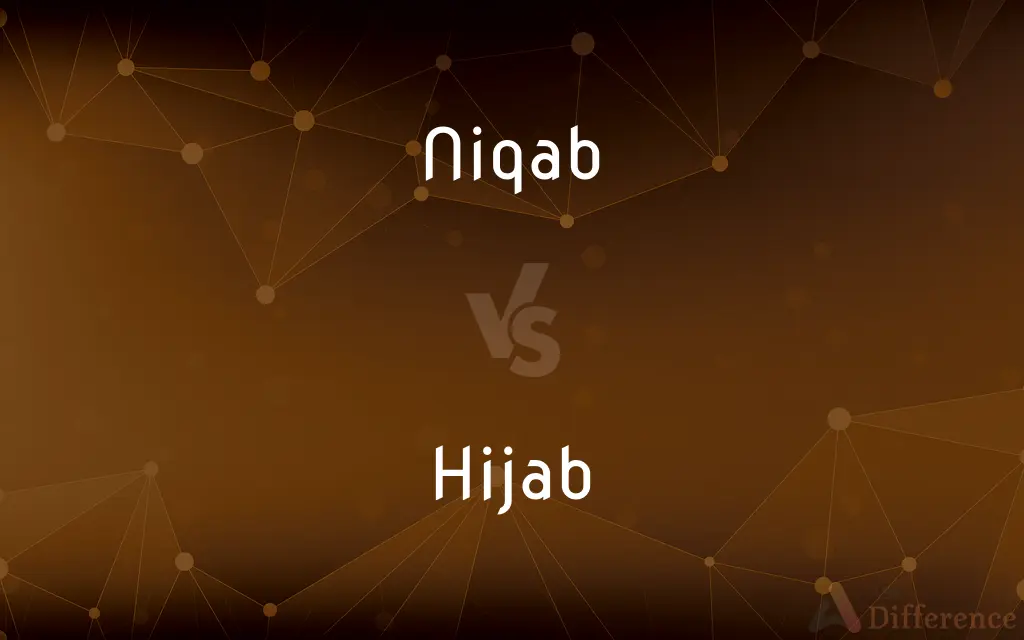Niqab vs. Hijab — What's the Difference?
By Fiza Rafique & Maham Liaqat — Updated on April 5, 2024
Niqab covers the face except for the eyes, emphasizing privacy and modesty in public, while hijab primarily covers the hair and neck, symbolizing modesty and religious faith.

Difference Between Niqab and Hijab
Table of Contents
ADVERTISEMENT
Key Differences
The niqab and hijab are both forms of Islamic veiling practices worn by Muslim women, but they serve different purposes and cover different parts of the body. The niqab is a face veil that covers the entire face except for the eyes, emphasizing a woman's privacy and modesty in public spaces. On the other hand, the hijab is a headscarf that covers the hair, neck, and sometimes shoulders, without covering the face, symbolizing modesty, privacy, and religious faith.
While the niqab is often seen in specific Islamic cultures and is considered a more conservative form of veiling, the hijab is more widely used across the Muslim world. The niqab signifies a higher level of modesty and privacy, often worn by women in Middle Eastern countries like Saudi Arabia and Yemen. Meanwhile, the hijab is recognized as a common Islamic practice, adhered to by women in various parts of the world, reflecting both a personal and cultural expression of faith.
The choice between wearing a niqab and a hijab can be influenced by various factors, including personal belief, cultural background, and societal expectations. The niqab is sometimes chosen for spiritual reasons, as a deeper commitment to modesty, while the hijab is often worn as a symbol of religious identity and modesty, accessible to the broader Muslim female population.
The discussion around the niqab and hijab also extends into public and political spheres, where the wearing of these garments can sometimes be a subject of debate. In some countries, laws and policies have been enacted regarding the wearing of the niqab and hijab in public spaces, reflecting broader discussions on religious freedom, integration, and security.
Despite the differences, both the niqab and hijab play significant roles in the lives of many Muslim women, offering ways to express their faith, identity, and values. The choice to wear either is deeply personal and can be reflective of a woman's commitment to her religious beliefs, cultural identity, and personal sense of modesty.
ADVERTISEMENT
Comparison Chart
Coverage
Covers the face except for the eyes.
Covers the hair, neck, and sometimes shoulders.
Symbolism
Emphasizes privacy, modesty, and sometimes spirituality.
Represents modesty, religious faith, and identity.
Cultural Usage
More prevalent in Middle Eastern countries.
Widely used across the Muslim world.
Personal Choice
Often reflects a deeper commitment to modesty.
Seen as a common expression of faith and modesty.
Public Debate
Sometimes subject to specific laws and debates.
Often involved in discussions on religious freedom.
Compare with Definitions
Niqab
Sometimes subject to public and political debate.
The debate on the niqab has sparked discussions about religious freedom.
Hijab
A headscarf worn by many Muslim women that covers the hair and neck.
Her collection of hijabs includes a variety of colors and fabrics.
Niqab
Symbolizes a high degree of modesty and privacy.
In her community, the niqab signifies a deep commitment to privacy.
Hijab
Part of broader discussions on identity and freedom.
She advocates for the right to wear a hijab in all public spaces.
Niqab
A veil worn by some Muslim women that covers the face except for the eyes.
She chose to wear a niqab as a personal expression of her faith.
Hijab
Widely accepted and practiced across the Muslim world.
She finds a sense of community among other hijab-wearing women.
Niqab
Reflects cultural and personal beliefs.
Her decision to wear a niqab reflects her cultural background and personal convictions.
Hijab
Can be styled in various ways.
She enjoys styling her hijab in ways that match her outfits.
Niqab
Can be part of a full-body covering.
Alongside her niqab, she wears an abaya to cover the rest of her body.
Hijab
Represents modesty, privacy, and religious faith.
Wearing a hijab is an important aspect of her religious expression.
Niqab
A veil worn by Muslim women that covers most or all of the face, having a narrow opening or mesh covering for the eyes.
Hijab
A hijab (; Arabic: حجاب, romanized: ḥijāb, pronounced [ħɪˈdʒaːb] in common English usage) is a religious veil worn by Muslim women in the presence of any male outside of their immediate family, which usually covers the hair, head and chest. The term can refer to any hair, head, face, or body covering worn by Muslim women that conforms to Islamic standards of modesty.
Niqab
A veil which covers the face, worn by some Muslim women as a part of sartorial hijab.
Hijab
Any of several cloth head coverings worn by Muslim women.
Niqab
A face veil covering the lower part of the face (up to the eyes) worn by observant Muslim women
Hijab
The veiling of women in some Islamic societies, customarily practiced in order to maintain standards of modesty.
Hijab
(countable) A traditional headscarf worn by Muslim women, covering the hair and neck.
Hijab
A headscarf worn by Muslim women; conceals the hair and neck and usually has a face veil that covers the face
Hijab
The custom in some Islamic societies of women dressing modestly outside the home;
She observes the hijab and does not wear tight clothing
Common Curiosities
Why do some women choose to wear a niqab?
Some women wear a niqab as a deeper expression of their faith, for increased modesty, or due to cultural and personal beliefs.
How does a hijab differ from a niqab?
A hijab covers the hair and neck without covering the face, while a niqab covers the entire face except for the eyes.
Can a woman choose not to wear a hijab or niqab?
Yes, the choice to wear a hijab or niqab depends on personal belief, cultural background, and sometimes legal requirements.
What is a niqab?
A niqab is a veil that covers the face except for the eyes, symbolizing modesty and privacy for some Muslim women.
What debates surround the niqab and hijab?
Debates often focus on issues of religious freedom, security, and integration, with varying laws and attitudes in different countries.
How are hijabs styled?
Hijabs can be styled in various ways, depending on personal preference, outfit, and occasion, ranging from simple wraps to elaborate designs.
Is wearing a hijab mandatory in Islam?
The interpretation of hijab as mandatory varies among Islamic scholars and communities, with many considering it an important part of modest dress.
Are niqab and hijab worn for similar reasons?
Both are worn as expressions of faith, modesty, and identity, though the niqab is often seen as signifying a higher degree of modesty.
How does the public perceive the niqab and hijab?
Perceptions vary widely, influenced by cultural, religious, and political factors, with some viewing them as symbols of faith and others as controversial.
Is it common to wear a niqab in Western countries?
While less common than the hijab, the niqab is worn by some Muslim women in Western countries, sometimes facing legal and societal challenges.
Do all Muslim women wear a hijab or niqab?
Not all Muslim women choose to wear a hijab or niqab, as practices vary based on personal, cultural, and religious beliefs.
Can niqab and hijab be fashionable?
Yes, both can be incorporated into fashion, with many women choosing styles, fabrics, and colors that express their personal style.
Share Your Discovery

Previous Comparison
Flamenco vs. Tapdancing
Next Comparison
Pub vs. CafeAuthor Spotlight
Written by
Fiza RafiqueFiza Rafique is a skilled content writer at AskDifference.com, where she meticulously refines and enhances written pieces. Drawing from her vast editorial expertise, Fiza ensures clarity, accuracy, and precision in every article. Passionate about language, she continually seeks to elevate the quality of content for readers worldwide.
Co-written by
Maham Liaqat












































